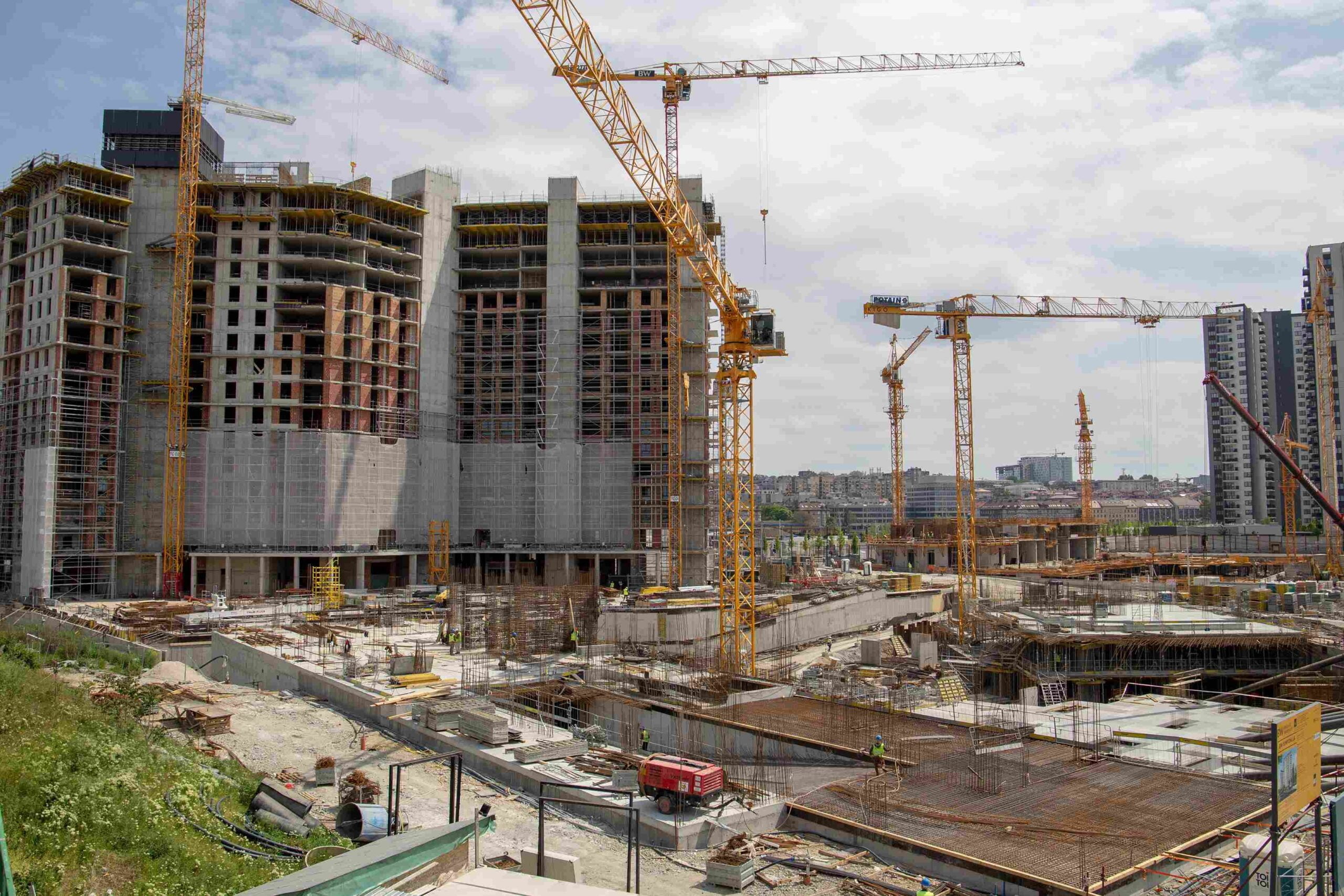What is a foundation in Building Construction?
In building construction, the foundation is the lowest part of the structure that is directly connected to the surface or ground. Foundations are the structural element of the building that is responsible for effectively transferring the total structure’s load to the underlying ground or soil. The foundation evenly distributes the total load to the ground and helps stabilize the building structure. Foundations are typically constructed with these materials: concrete, masonry, steel, etc. It is designed considering factors like soil composition, bearing capacity, building load, and environmental factors. The foundation is critical to maintaining the building’s stability, durability, and safety of the building. Foundations are generally constructed in two ways: shallow or deep.
Types of Foundation in Building Construction
The foundation is a very important structural element in building construction; that’s why it is necessary to know about every type. So that we can select the best foundation for our house or building. Foundations are classified into two important types: shallow and deep foundations. Further, these two are classified into different types based on their functions and uses.
Shallow Foundations
Shallow foundations are designed for low- to medium-weight structures where the stable soil is closer to the ground surface. This type of foundation is an effective and popular choice for small-scale projects like residential buildings, small commercial buildings, shops, and light industrial buildings. They are easy to construct and cost-effective as compared to deep foundations. Below, some of the types of shallow foundations are explained:

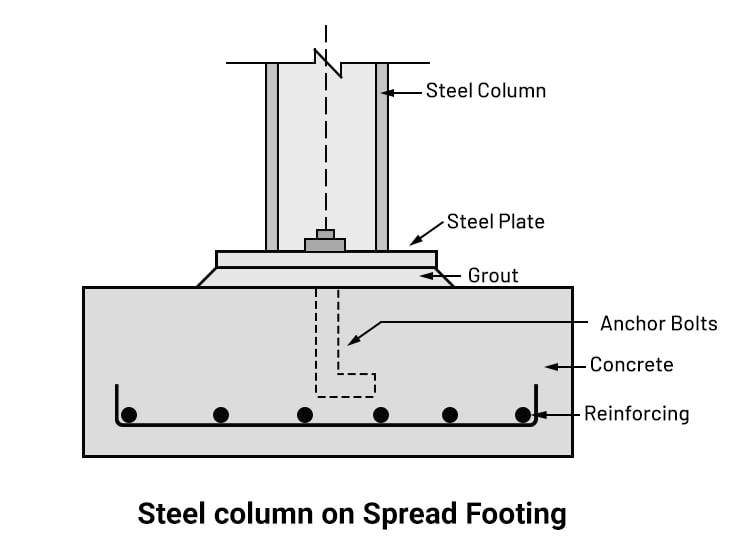
Eccentric or Corner Footing
It is a type of footing in which the column is not designed at the center of the footing slab. Eccentric footing is designed for the corner column or for the columns that are designed at the edges of the walls or the boundary of the building. The load generated by the columns shifts from the center to the one side or two (in case of corner footing) of the footing; thus, it is referred to as eccentricity, and that’s why this type of footing is known as eccentric footing. [1]
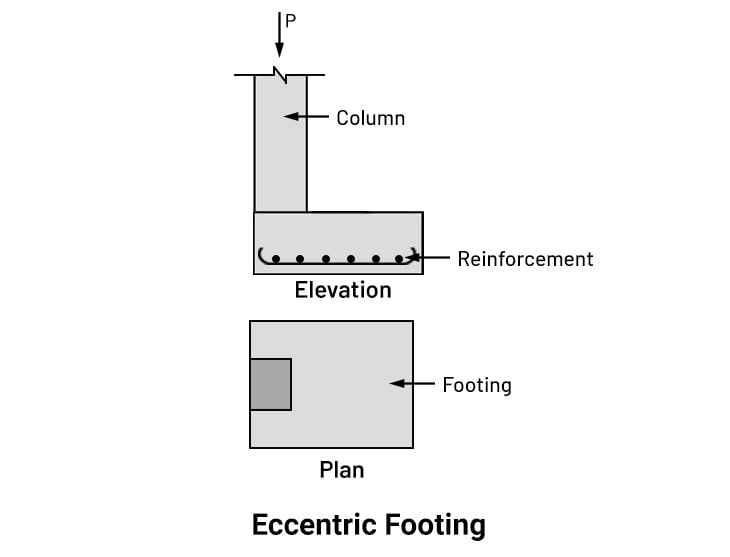
Isolated or Individual Footing
It is also known as pad foundation, is the most common type of footing used for the foundation of buildings. Isolated Footing has three types: the first is a simple pedestal with a column on it, known as a pad foundation. Second, stepped footings generally have 2-3 steps and a column at the center. It has more strength than the pad foundation. The third and last one has a sloped footing; the pedestal has a slope on four sides, and the column is at the center. It also has more strength than the pad foundation. All these footings are individual and carry the load of a single column. They carry the load and directly transfer it to the underlying soil. These footings are ideal for the buildings, which have five storeys. The type of footing selected for the foundation depends on the load type and condition of the soil.
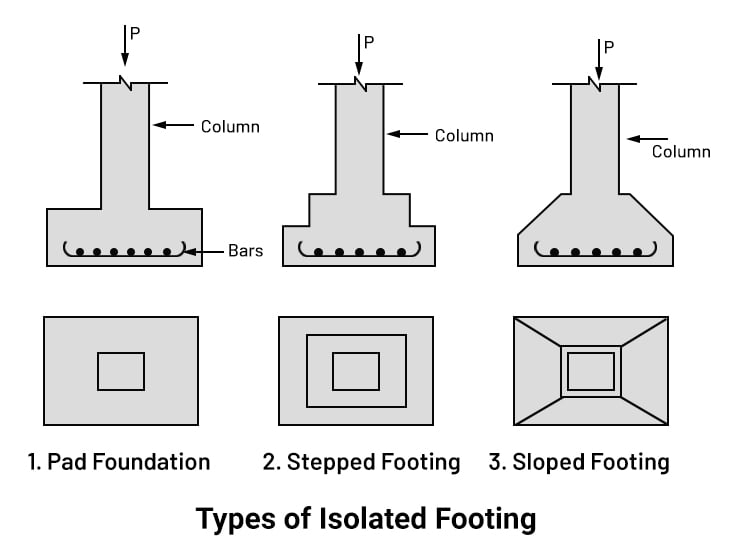
Combined Footing
Combined footings are the type of footing that is constructed in two cases: first, when two or more columns are closely placed next to each other, and second, when two isolated footings are near each other and have less gap in between. To make the footing more effective, both the isolated footings are combined. Combined footing spread the load between the columns and reduced the risk of differential settlements. Combined footings can be constructed in rectangular and trapezoidal shapes.

Strip or Wall Footing
Strip footing, also known as continuous footing, is used to support a linear structure like a wall. The footing runs along the load-bearing wall and provides support. Strip footing distributes the load of the building evenly over a larger area of soil, providing stability and preventing settlement.
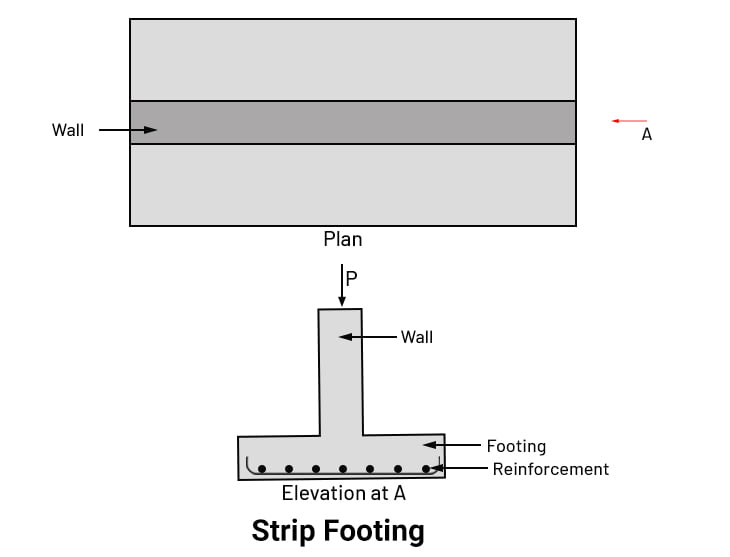
Cantilever or Strap Footing
It is a type of combined footing where footing is not combined in case the distance between two columns is two more, but combining them together will increase the strength of the footing. Then the footing is not combined; rather, the columns are combined with a beam. Doing so makes the footing economical, and the beam distributes the load to each footing to increase the strength and bearing capacity of the footing.

Raft or Mat Foundation
This type of foundation is designed over the whole footprint of the building. It has a thick reinforced concrete slab covering all the area, and columns are placed over it. This type of foundation is used in areas where the soil is not in good condition or has a high groundwater table. This type of foundation can support heavy load of the building, and it evenly distributes the load coming from the columns.
As compared to other shallow foundations, constructing a raft foundation is costly and is used when the structure requires a heavy foundation or when constructing isolated footings is not beneficial for the building.

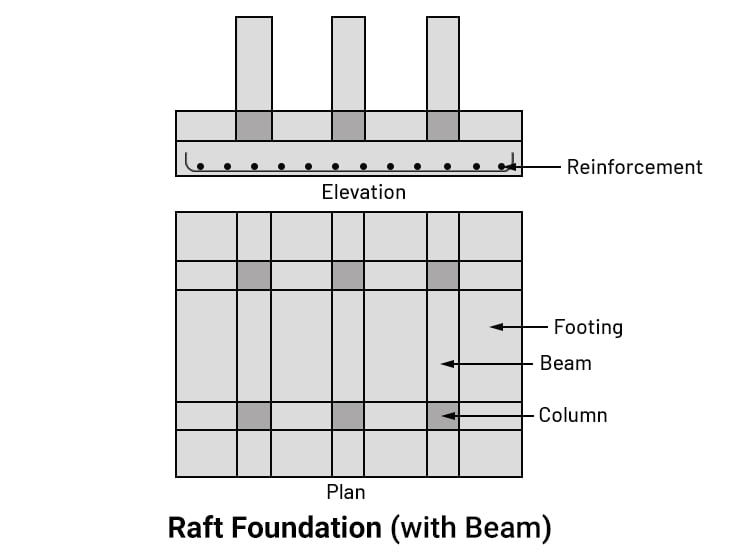
Deep Foundations
Deep foundations are designed for high-weight structures where load-bearing soil only occurs at a great depth. This type of foundation is an effective choice for big projects like malls, exhibition halls, auditoriums, industrial building, etc. They are suitable for heavy structures or where the hard soil is not available near the surface. Below, some of the types of deep foundations are explained:
Pile Foundation
It is the strongest type of foundation used for the construction of the building foundation. Pile foundations are used for heavy structures like skyscrapers, where the loads need to be transferred to deeper, more stable soil or rock layers. Pile foundations consist of a number of piles that are penetrated deep into the soil and supported from above by the pile cap. These piles are constructed of concrete, steel, or timber and drive deep into the ground to support the building.
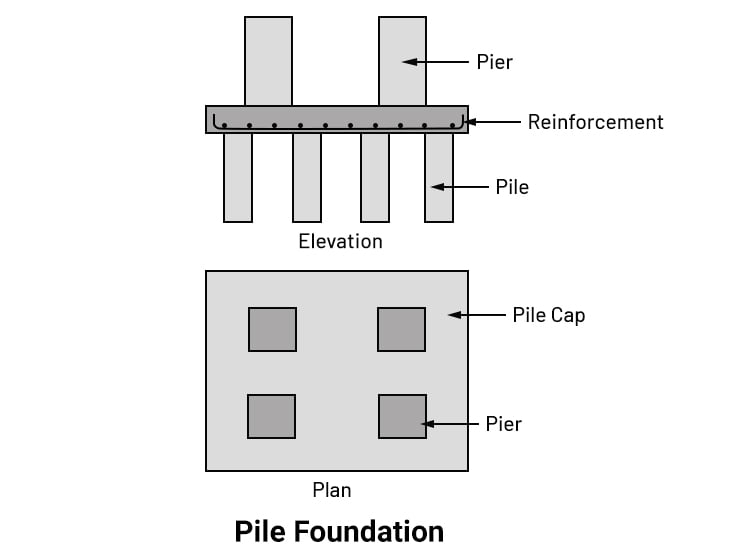
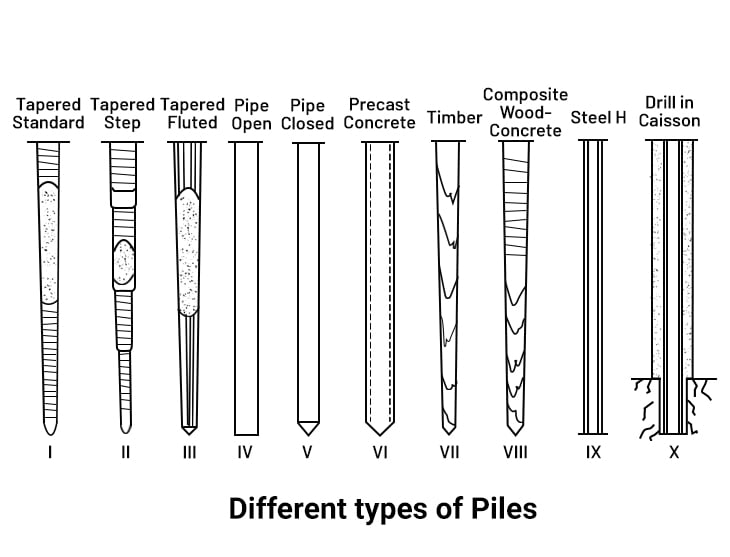
Caisson Foundation
Caisson foundations are more effective than pile foundations. Mostly caisson foundations are used for bridges, docks, and larger structures. Where foundations are required beneath water bodies or rivers. They are used in areas with deep soil layers or areas prone to heavy wind and seismic activity. It is constructed by drilling deep into the ground and then filled with concrete or reinforced with steel.
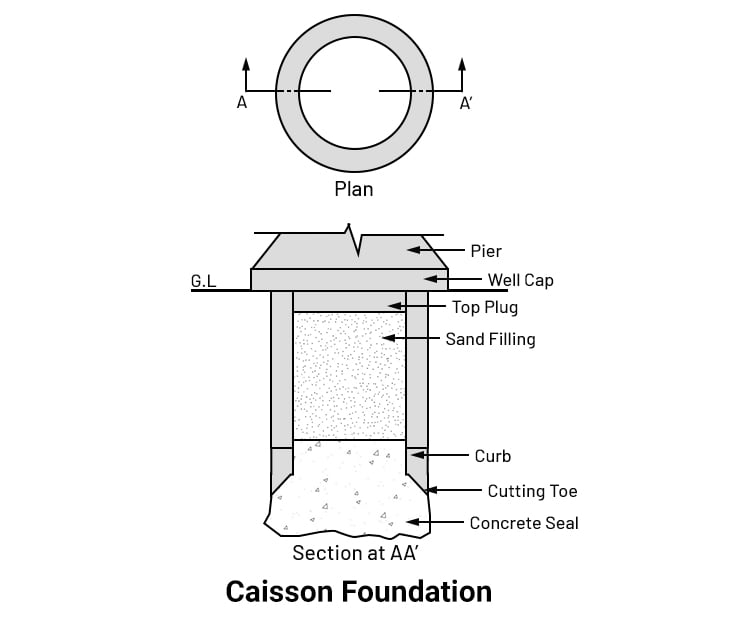
Selection of type of Foundation to be used for Building
One of the most important decisions in designing and constructing any building is the determination of its connection to the earth, which supports the structure. The earth’s substratum is investigated and tested to help define the soil conditions beneath a proposed foundation site.
The most common types of footings are isolated footings and wall footings. These are used where the soil’s bearing capacity is adequate for the applied loads. The applied loads accumulate from either column loads or bearing wall loads. Variations of isolated footings include eccentric footings, where the center of the superimposed load does not line up with the resultant center of the soil bearing pressure; combined footings, where two or more columns must share one footing; and raft footings, where the required superimposed loads require most of the building’s footprint to transfer the accumulated loads to relatively weak soil bearing capacity.
Pile foundations are required where poor surface and near-surface soils are weak, and column-like shafts must be used to penetrate the weak soil and reach an acceptable supporting layer and greater depths below grade. Piles are tied together with pile caps, upon which the building’s columns or walls are supported. When large column loads exist, caissons are used as extensions to columns. Caissons are typically larger in diameter and longer. They rely on end bearings directly on earth, which have a very high bearing capacity. (Source: Timesavers for Architecture)
Soil investigation for Building foundation
If there is insufficient local experience about the properties, extent, bedding, and thickness of the soil strata on the site, a soil investigation performed as early as possible by a geotechnical specialist is essential. The specialist can obtain information through trial pits (excavator or hand excavation), drilling boreholes (auger, rotary, or core drilling), sample extraction, and probing (number and depth depending on the topography, structure, and particular investigation). The groundwater table is measured with gauges in boreholes and regular measurements of variations in level.
Soil samples are tested for grading, water content, consistency, density, compressibility, shear strength, and permeability. Probing provides continuous information about the strength and density of the investigated depth. Groundwater samples can be investigated for aggressiveness towards concrete. The results of the investigations are provided to the client as a site investigation report.
Incorrect interpretation of the subsoil and groundwater conditions and the behavior of the planned foundations often lead to technically and economically irreparable damage. This applies particularly to lateral displacement of the soil under foundation loading (load-bearing failure of the ground, slope failure), where the foundations sink into the soil or are laterally displaced, or settlement, through compression of the subsoil under the foundations due to ground pressure or loads applied next to the foundations. The results can be deformation or cracking in masonry. (Source: Neufert)
Steps to be followed to build a Building foundation
Once you decide to build your dream house, the next step is to approach an architect and have a detailed planning and designing of your house. But that’s not the job done, the vital step is to lay the foundation of your building that will hold your house and provide structural safety. It distributes all the load of your house to prevent the plot’s subsoil from spreading and causing and structural damage. A good foundation not just simply hold the building structure above the ground. It provides strength, stability, insulates against cold, keeps out moisture, protects from pests, and resists movement of the surrounding soil. And a good foundation should last forever and hold your building structure.
It’s not easy to lay a foundation, as I have described above about soil testing, water table study, soil conditions, and quality of backfilling. Let’s discuss the steps to lay a good foundation for your house:
Prepare the foundation layout
The foundation layout drawing for excavation can either be prepared by an architect or structural design, but it should be approved by an architect only. Once the architect approves the foundation layout drawing, that drawing should be followed by a site engineer or contractor. As per the drawing, the marking of the foundation layout will be done with chalk powder on site. After that, an architect will cross-check the dimensions so that they do not have any errors.
Excavation Work
Once the architect approves the foundation layout marking, you can proceed with the excavation work. The excavation work is done according to the method you have chosen: Load-bearing wall or column beam frame structure. If it is a load-bearing wall, then the trenches for excavation will be done along the wall. But if it is a framed structure, then the excavation will be done below each and every column of your house. The trenches for every column should be dug to a minimum of 1500 mm from the ground level (you can go above it depending on the structural load of the column). The trenches should not be dug in a cuboidal shape; a minimum of 500 mm of space should be left from the edge of the footing for labor work.
A cuboidal trench is not safe to dig as it can collapse, so the trench edges should be dug at an angle of 70°.
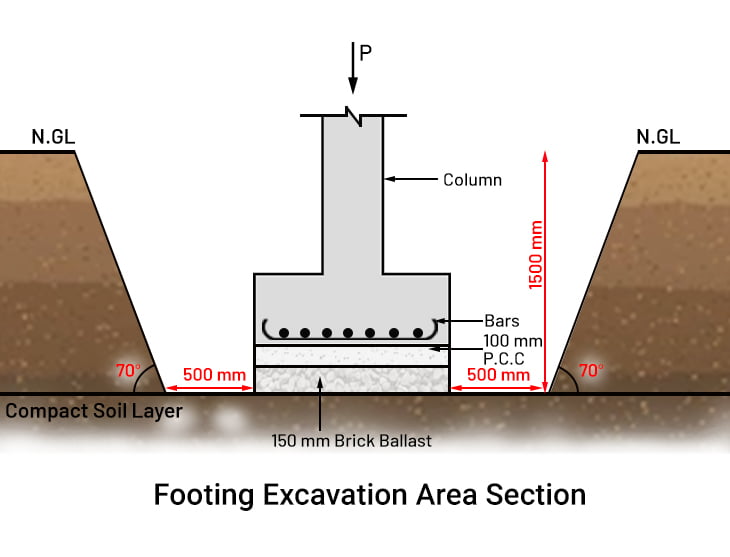
Anti-Termite Treatment
Once the excavation work is done for the foundation, Ensure that the excavated area and the trenches are treated with anti-termite chemicals. The treatment should be up to plinth level with appropriate chemicals. It is done to protect your house from termites and other pests from entering your house or damaging the structure.
Construction of the Foundation
The next step is to lay the foundation. It can be done depending on the method you have chosen.
For load-bearing structures, a PCC bed will be laid at the base of the trenches, and then brick or stone masonry will be constructed over it as per the foundation details given by the architect and structural engineer.
In the case of a column beam-framed structure, column footings are constructed in the trenches as per the steel details approved by the structural designer and architect. Then pour the concrete into the footing to the plinth level. After all this is done, a plinth beam is erected (as per the approved drawings) on which the walls of your house rest.
Curing of the foundation
Once all the above steps are done, it’s time to cure the foundation. It should be done the next day after the poring of concrete is done. The curing should be done twice or three times a day. It is done to avoid cracks and a decrease in the strength and life of the building components. Curing ensures a sufficient amount of water is provided to the concrete for the chemical reaction that provides strength to the concrete. [2]
Elements used for Building foundations
Concrete
To read the main article on this topic click here: Concrete
Concrete is a long-lasting construction material made of Portland cement, aggregates (such as sand or gravel), and water. Concrete is prepared by mixing together these materials to form a slurry that hardens over time to create a solid mass that is capable of withstanding massive amounts of load and environmental conditions. It is the most widely used construction material worldwide. It provides strength, versatility, and durability, making it a key component in building foundation, pavements, structural elements, decorative finishes, components, and others.
Concrete Cover Blocks
Concrete cover blocks are used in construction for two major reasons: first, to provide support to the steel bars and hold them in place. And second, because of these concrete cover blocks, a concrete cover is made around a steel reinforcement cage. A concrete cover is a protective layer that holds steel bars at a place and doesn’t allow them to tear the concrete. The dimensions of the concrete cover range from 15 to 75 mm; these are used for different structural elements like footings, slabs, beams, columns, staircases, etc.
Concrete cover blocks are available in different shapes and sizes and are used for various purposes. Concrete cover blocks are available in dimensions of 20 mm, 25 mm, 30 mm, 40 mm, 50 mm, and 75 mm.
Steel Bar and Stirrups
The slurry of concrete is reinforced by steel bars, which makes it the strongest material used for construction. The reinforcement of steel bars also enhances the tensile strength of the concrete. Steel bars are not directly put into the concrete to form a structural element. These bars are arranged in rectangular or square form, then bind with stirrups by binding wires. Together, they form a steel reinforcement cage that is used to make different structural elements like columns, beams, footings, staircases, slabs, etc.
Formwork or Shuttering
Formwork, also known as shuttering, is a temporary structure that is used to contain the poured concrete and then mold it into the required structural element. It contains and supports poured concrete until it achieves sufficient strength to support itself. It plays a crucial role in shaping the concrete into the desired form and ensuring the quality and integrity of the finished structure. Shuttering can be done with these materials: timber, plywood, steel, precast concrete, etc. They can be used separately or in combinations to make the desired formwork.
What is prefabrication and its use for foundation works?
Prefabrication, often referred to as prefab, is the process of manufacturing or assembling components or modules of a structure off-site in a factory or workshop. Then it is transported and assembled on site. Doing the work like this makes it faster and takes less time to finish a job. Prefabrication offers a lot of other benefits, like increased efficiency, improved quality controls, reduced material waste, minimized site disruption, reduced labor costs, and several others.
Uses for Foundation Works
- Precast concrete foundations include elements such as footings, piles, and columns.
- Prefabricated modular foundation blocks or panels can be used to create raised or elevated foundations for buildings or structures.
- Entire foundation systems, including footings, walls, and slab components
Types of Foundation used for different soils
The building rests on earth, and hence, the quality of the soil matters for the foundation. Designing for the type of soil on site also means choosing the right foundation. Most of these are very technical decisions, as they impact the life of the structure and its stability. It is advisable to consult with an engineer to make the right decision. The following table has been segregated by soil type to help you with broad-base foundation-related tips. Please note that there are many other conditions that determine the nature of the foundation.
| S. No. | Soil Type | Foundation Type |
| 1. | Clayey Soil | Raft or Pile Foundations |
| 2. | Peat Soil | Strip Foundations |
| 3. | Silty Soil (if firm and deep) | Isolated Footing |
| 4. | Sand (Compacted) | Spread Footing |
| 5. | Loamy Soil | Isolated Footing |
| 6. | Rocky Strata | Strip, Pad or Raft Foundation |
Mixed-composite soil is always preferred as it is economical for building foundation. The suggestions here are generic. Every soil should be tested before designing the foundation of the building, and recommendations should be given by qualified structural engineers. (Source: IIID Design Handbook)
Uses of foundations in Building Construction
- Evenly distributes the structure load to the underlying soil.
- It provides strength, stability, durability, and longevity and prevents the building from settling or moving.
- Helps in transferring the above superstructure (walls, columns, slab, etc.) loads to the ground.
- Offers resistance against lateral forces like wind, seismic activity, and soil pressure.
- Provides a stable and leveled base for the construction of walls, floors, and other building elements.
- Foundation helps in creating buildings on any terrain and soil type, including slopes and even on uneven ground.
Building Foundation Design Considerations
- Selection of foundation as per the soil type, structural requirements, and soil conditions.
- A minimum of 1500 mm (5 Ft.) of trench should be dug from ground level for a footing.
- The trenches should be dug at an angle of 70° (from the edge of the footing) so that they do not collapse.
- After marking the foundation layout with chalk powder on site, it should be cross-checked before excavation.
- The marking of the first footing should be done in X and Y coordinates so that it is easy to locate the first footing and the remaining footing according to the drawings.
- The center line of the column or footing should be marked with thread so that no footing or column displaces from the located point (as per drawings given by the architect).
- Before pouring the concrete, all the reinforcement cages should be thoroughly checked for any errors.
Advantages of good foundation
- Increase the resale value of the house by demonstrating the quality of construction and structural integrity.
- Enhances the overall performance and efficiency of the building.
- Refer uses of foundation for other advantages.
Disadvantages if the foundation is weak
- Risk of structural instability, leading to potential collapse or failure of the building.
- Weak foundation leads to generate cracks in walls, floors, and other elements of the building.
- Reduces resistance to lateral forces such as wind, seismic activities, and soil pressure.
- Repair and renovations is needed in future to make the building stable.
- Not safe for the occupants of building and neighbors.
Difference Between foundation and Footing
| S. No. | Footing | Foundation |
| 1. | A part of the foundation that is in contact with the ground | A construction component that distributes structural loads to the ground from the superstructure. |
| 2. | Provides support for the individual columns. | Provides support for the entire superstructure. |
| 3. | It is a type of shallow foundation. | It can be a shallow or deep foundation. |
| 4. | All footings are foundations. | Not all foundations are footings. |
| 5. | Types: Strip footings, spread or isolated footings, combined footings. | Types: shallow foundations and deep foundations. |

